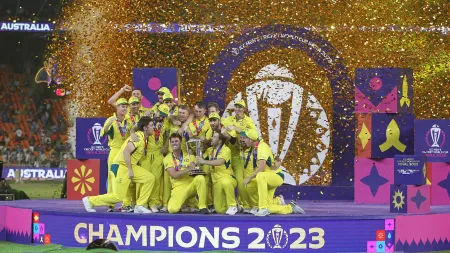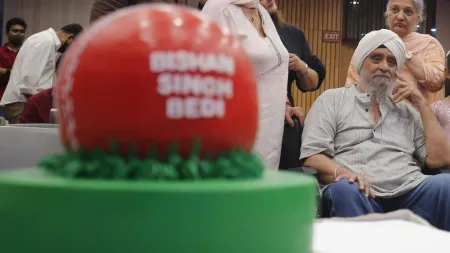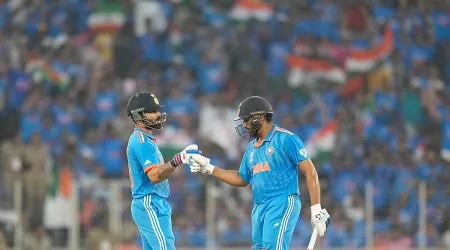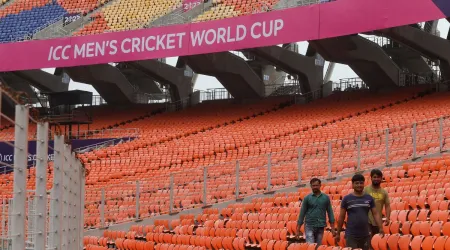- India
- International
Narsingh Yadav vs Sushil Kumar: SWOT analysis of the two pehelwans
Shivani Naik weighs into the debate by asking the experts to dissect the strengths and weaknesses of the two pehelwans — Narsingh and Sushil.
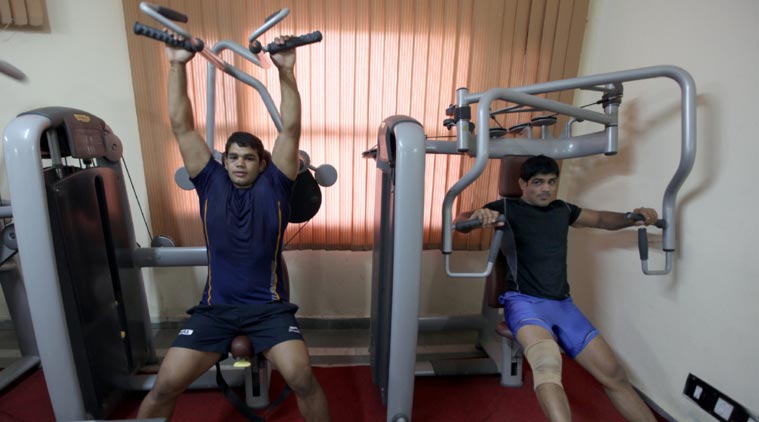 While Narsingh is a cool-headed counter-attacker who bides his time before he swoops in on an opponent, Sushil is aggressive start-to-finish – or at least has been in his 66kg career. (Source: Express file photo by Ravi Kanojia)
While Narsingh is a cool-headed counter-attacker who bides his time before he swoops in on an opponent, Sushil is aggressive start-to-finish – or at least has been in his 66kg career. (Source: Express file photo by Ravi Kanojia)
Trial or no trial, two-time Olympic medalists versus World Championship bronze winner, champion with pedigree or proven performer in the 74 kg. Shivani Naik weighs into the debate by asking the experts to dissect the strengths and weaknesses of the two pehelwans — Narsingh and Sushil
It’s perhaps a mythical tale that’s not gotten lost in the sands of time — or sand dunes of Rajasthan. Circa 1912, the Maharaja of Alwar, whose royal gaze oversaw some fantastic beasts in his green expanse of a backyard, decided one day to have a tiger fight against a lion.
Tigers, you know, have manic strength; lions not so much, though they could boast roaringly of a gallant gut and a valiant heart. It’s not who won which was the only takeaway for those that gathered for this regal spectacle that day. What it resolved though, was that seeing was more of an exact science than merely believing who was strong. And that when it came to survival, strength wasn’t just measured in pounds; it could be an invisible, unquantifiable superpower.
Cut to a 100 years later. The curiosity that this scorching Indian summer shrouds is the fate of two equally adored brutes – wrestlers Sushil Kumar and Narsingh Yadav, both polite and peaceful when you meet them outside of the mat, both proud and pitiless when they are hunting prey on it.
The question of who’s the better wrestler in their 74 kg lair ought to have crossed every wrestling supporter’s mind. The national federation that rules over these matters would have us believe that winning an Olympic quota and consistent performances in 74 kg capped with a World Championship bronze medal should suffice in establishing who’s best suited to go to Rio. It supresses the fundamental debate – of who is a better wrestler, in this case. For what else is there to decide in sport? And it doesn’t answer Indian wrestling’s most pressing poser – which of the two can win a medal (preferably a better hue) for India?

Sushil vs Narsingh could be a bout for the ages, only if a federation cared enough to find out who their best wrestler in 74 was. Minus a trial, Narsingh Yadav is hardly the obvious answer. The federation’s choice and holder of the quota place – he earned it at Las Vegas, and sure has a lot going for him.
“Narsingh should win soundly,” says Mike Malinconico, the international style technical advisor at Flowrestling.com and a coach of many decades at the Rhino Wrestling Club in New Jersey, US. A neutral voice at a time when Indian opinions are highly polarised, and more importantly a long-standing coach who has followed both wrestlers’ international bouts far more closely than most Indians, Malinconico reckons that Sushil just hasn’t competed enough – or, at all — since 2014. “First, Narsingh’s bigger and second, he is immersed in the sport. Sushil, having taken 2 years off, has let the sport pass him in many ways,” he says of the younger man who has wrestled for a medal in 2 of the last 3 world championships.
But the debate is hardly this cut and dry, for Sushil’s monumental achievements cast a hulking shadow immediately on this fight.
Sushil has Malinconico’s respect on sheer account of wrestling at the international level for the duration of three Olympic cycles and being a two time Olympic medallist. “That puts Sushil Kumar in very rare company. He’s a legend, not just in India, but in the wrestling community,” he avers.
That’s the thing with this debate — every argument and its counter will end in a stalemate in the absence of a real head-on clash.
Narsingh elevates the debate from being merely about Sushil’s past because of what he promises in the future.
Malinconico watched Narsingh being comprehensively matted by American legend Jordan Burroughs at the Budapest Worlds in 2013. The 26-year-old morphed into a respected competitor thereafter. “The only losses that he had in 2013 were to Burroughs and Shabanau, who’ve wrestled for a medal in every world event of the past 5 years,” he assesses. For close to a decade now, the 74kg has been a preserve of either the US or Russia, so Narsingh’s wrestle-off for a medal in 2 out of the last 3 years cements him as one of the elite athletes while beating some good blokes in that weight class.
And he is a beast of a physical specimen.
“World’s best upper body,” says Sandeep Yadav, a Greco Roman World medallist from Mumbai, also Narsingh’s closest buddy. It is what gives him the early advantage on the start-fight stance in the initial sparring in bouts when wrestlers lean forward and start looking for dominance – on waist or wrist holds or the hooks under the armpit. His formidable upper torso can act like a sturdy wall in defense or a wrecking ball depending on the situation, and it allows him to defy an opponent’s plans of putting him off balance.
Then, there’s the sheer grip — like a python’s choke, which opponents find difficult to escape from, with the full force of his weight capable of dragging opponents. And the stopper hands.
They talk of his broad chest and head to heel strength – built like a ram, and finally, the crushing power of his hand. “I think my grip does the job,” Narsingh says, adding that training with his best bud Sandeep Yadav in Greco Roman (where holds below waist are disallowed) has added to his technical prowess (like in Dasti khichna daav) exploiting his natural strength.
One early criticism of him was that despite the power, his upper body was stiff and not as agile as it could be, but the wrestler has worked on this aspect in the last few years, and waist-up, he can turn into an immovable boulder of a force.
Malinconico reckons the 26-year-old Indian has exploited it to the hilt. “Narsingh’s upper body attacks are a source of confidence. He’s never “out” of any match. They act as his “equalizer” as we saw in his bronze match last year in Las Vegas,” he says.
At Vegas, the medal winning dhaak move came as a culmination of two prior attempts at snaring his rival with the same tactic – each bulldozing charge stronger than the preceding one like a snake’s strangle.
This upper-torso-bullish advantage masks the relative vulnerability on his lower body – a result largely of him being a truer akhada wrestler who relied on digging his toes into mud for a foothold. But there’s no denying Narsingh the reputation he’s built as an ace counter-attacker – that’s the fulcrum of his technique. It’s not just how he can wriggle out of an opponent’s stranglehold with an explosive counter, but also how he uses the opponent’s weight with seemingly the same languid demeanour.
“You know exactly what he’s doing, and better wrestlers can even predict what precisely he’ll do. But you can’t stop him from doing it anyway,” Sandeep Yadav says. At Mumbai’s SAI centre his sparring mates – larger men who are reduced to punching bags, talk of his dab-dabaav (high pressure he exerts in counter-attacks) and how he can pounce from a seemingly weak position and effect a dhobi pachaad in micro-seconds.
Narsingh is known to create angles off his opponents’ attack very well. “He’s very fast at getting to the weakest point on his opponents’ leg (closer to the ankle),” Malinconico says.
“With 30 seconds left in Vegas and trailing by 8 points I knew I won’t win by points and needed a fall. At that moment I could pull off my counter,” Narsingh says. His body bulk gives him the all-important ‘dodge’ and the man has deceptive speed when he retorts and upturns an attack.
Different styles
While Narsingh is a cool-headed counter-attacker who bides his time before he swoops in on an opponent, Sushil is aggressive start-to-finish – or at least has been in his 66kg career. Not much had changed at the 2014 Commonwealth Games in Glasgow (his only serious international meet in 74 kg) where his lunge on the Pakistani Qamar Abbas in the final to wrap up the gold medal match within the first period (in 10 seconds) showed his relentless, second-skin intent to attack. It’s the mightiness of Sushil’s haathi chingaad against the slow wearing out of the opponent in dhaaks and bagal dhoop and the nifty Irani tangi from Narsingh.
People still talk about the swiftness with which Sushil settled matters in the London Games semifinal, and Malinconico likens him to the cream of American wrestlers and their go-to style. “He has a very American style of wrestling. Athletes in our sport are known for being very aggressive, they like to pull on their opponents’ head and wear them down. Sushil does all of these thing well,” he says. Albeit, in 66. “Sushil was one of the strongest athletes at 66kg, he would have no qualms about going through his opponents lines of defense (their head and hands).
Narsingh on the other hand is versatile in the American’s opinion – his wrestling’s lineage is more eastern European.
Narsingh would rather go around his opponents’ head and hands instead of through them. While both he and Sushil have very heavy hands when pulling their opponents down Narsingh uses very fast footwork to create an angle on his opponent and get to their legs that way. For Sushil, his low crouching stance and his busy hands suffice.
Why Narsingh’s never caught the imagination of Indians – despite consistent showings in 74kg (he has a commendable 9 top-five finishes internationally since 2013) and the World Championship bronze, is because reputations in wrestling get built on being a consistent podium top-3 finisher.
For long, Narsingh was caught in the defensive mindset nursed by most Indian wrestlers —save Sushil and Yogeshwar. The Mongolian Unurbat Purevjav who beat Narsingh at the Vegas semifinals had exploited this propensity. “I was very defensive at the start, I should’ve attacked immediately,” Narsingh rues. He was proactive during the wrestling league in India where he won 7 out of 7, but against the top names it remains one of Narsingh’s criticisms.
Advantage Sushil
Sushil scores not only in this unabashed offensive style, but has also built himself a reputation. “He might not have fought a lot recently, but being a consistent medallist gives you an aura,” says a coach at the camp who’s closely worked with both wrestlers. “Yes, there’ll be apprehensions about transition from 66 to 74 but Sushil is just not used to losing. His mat-craft should not be under-estimated,” the senior coach says.
Coach Satpal – who plotted his own bronze, silver, gold at 3 successive Asiads ’74, ’78, ’82 – might be a big boast when he talks of his ward’s 2000 baithaks. But he is not exaggerating when he says Sushil can summon the lakkad bagga or any of the 40-50 more advanced techniques at the swiftest of mental speeds. He talks of the confidence-boosting “khoonkhaar training” last year but there’s the other bombastic claim that might not be far from the truth.
“Opponents ke mann mein khaunf baith jaata hai Sushil ka,” Satpal stresses, adding that Sushil skipped the league only to avoid aggravating injury. “He’s at his peak fitness now. Check him at trials.”
A mud wrestler in his early years, Sushil however took to the mat like duck to water very early on. So, even if he could be subjected to a different weighty ‘resistance’ in 74kg – which indeed needs getting used to – his ease on the mat through nimbleness of footwork is a few notches better than Narsingh’s. “He reminds me of a crouching panther,” says a coach from Maharashtra. “He has that stealth and cunning which Narsingh simply doesn’t. It can’t be suddenly learnt,” he says.
Sushil brings that swag to the mat, and his body language – irrespective of 66 or 74 – carries more heft than Narsingh’s does, almost challenging that upper body advantage his opponent enjoys. Watch a Sushil bout, and it’s fascinating to follow his eyes, constantly searching for openings, perennially looking for a weakness to pounce on.
Weight and watch
Sushil’s relative lack of mat-time internationally after the switch from 66 to 74 is what his critics will throw at him. Many might reckon that going up in weight class from 66kg to 74kg would give Sushil a speed advantage, but speed was never the predominant part of Sushil’s game. “He relied more on strength and aggression, Sushil relinquishes many of the advantages that he had at 66kg when competing at 74kg,” Malinconico says.
However, Sushil’s camp feels that he has fought enough with sparring mates of higher categories to not feel daunted by the 8 kg steep step up. 66 to 74 is a 12 per cent increase from Sushil’s previous fighting weight. Though it’s not as significant as in boxing where reach and power of punch can be all-important (like Brit boxer Amir Khan realised against Canelo stepping up divisions), the biggest challenge when moving up weights is in getting used to the Resistance. It’s about holding your ground against a heavier force overpowering you, defying a human torque in defense as well as matching muscular power in offense. Workloads increase multifold, though at 2000 push-ups a day he has taken on the same workrates as of heavyweights. As such, Hari Birajdar (82kg) beat Satpal (at 90kg), and later Satpal could get the better of super heavyweight Topanna (around 130kg). So there is nothing that good technique cannot overcome.
“Sushil’s walk around weight is 74+ and he has fought with bigger guys where his strength and experience were enough,” says Dr Nikhil Latey, who has worked with Sushil on strength training through Olympic Gold Quest.
“Earlier Sushil had to come down from 74 to 66. Being in 74 has allowed him to pack on muscle as he doesn’t have to lose so much weight,” he says. He regularly trained with the 84 kg Georgian qualifier and at Sonepat took on half a dozen pehelwans from 60 – 120 kg back to back, his coaches inform.
There’s all the Olympics buzz about Jordan Burroughs, the American defending champ and World gold winner. “Geduev from Russia is right there with Boroughs. Takatani (JPN), Shabanau (BLR), Ghasemi (IRI), and Narsingh should all wrestle for medals (depending how the brackets gets drawn),” Malinconico says.
If both Sushil and Narsingh are in the shape that they ought to be in this close to the Olympics, a trial will determine who’s best suited to go, though worries of rigged refereeing and a cynical fight where both wrestlers risk injuring need to be addressed. Malinconico says, “If it were marketed correctly it would be fun to watch the “changing of the guard”. Change of guard, or not if Sushil has his way and holds sway.
Sushil holds the edge though, as experts claim that it would be an almighty mental challenge for Narsingh to go into a high-pressure do-or-die against a celebrated senior and break free of the shackles typical to Indian pehelwaans – the respect, awe, etc that accompanies such face-offs. Accustomed to touching Sushil’s feet before stepping onto the mat till few years ago, Narsingh might quiver just a tad in clutch plays. It would do Narsingh’s confidence a world of good to put away Sushil before he goes to Rio.
The way this has panned out, there’s the inevitability to answering that question: Who is India’s better/best wrestler to go to Rio? Not fighting Sushil at all, can be a lifetime’s cross to bear for Narsingh.
Considered a superior grappler and an overwhelming favourite by his coaches, the federation, even international experts after Narsingh started ruling his weight class in the country, you get a sneaking suspicion that the man himself might not believe in the tag of being the ‘best 74kg wrestler of India.’
Is it Advantage Sushil in case of a trial?
P.S: The lion trumped the tiger at the royal retreat in Alwar.


















